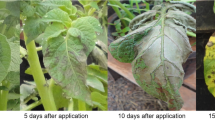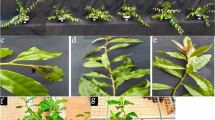Abstract
The technique of biofortification with selenium (Se) in several agricultural crops has been well researched by the scientific community. However, for vegetable crops cultivated in tropical conditions, there is still little information. The objective of this study was to evaluate the effect of the application of Se in the soil on physiological, agronomic, biofortification and antioxidant enzyme activity in tubers of Solanum tuberosum L. grown in tropical soil. Potato plants (cv. Agata) were cultivated in pots (7 kg) with soil that received two sources of Se (selenate and selenite) and five doses of Se (0; 0.75; 1.5; 3.0 and 5.0 mg kg−1). The results showed that the application of Se by both sources increased its content in the tubers. When applied in small doses, it provided beneficial effects on the production of tubers, increased Ca content in shoots and activated enzymes of the antioxidant system. High doses, in addition to decreasing production, reduced S content, pH and peroxidase activity in the tubers. Thus, selenate is the most efficient source for biofortification of potato under tropical conditions when supplied in low doses.







Similar content being viewed by others
References
Ahmad R, Waraich EA, Nawaz F, Ashraf MY, Khalid M (2016) Selenium (Se) improves drought tolerance in crop plants—a myth or fact? J Sci Food Agric 96:372–380. https://doi.org/10.1002/jsfa.7231
Alyemeni MN, Ahanger MA, Wijaya L, Alam P, Bhardwaj R, Ahmad, P (2017) Selenium mitigates cadmium-induced oxidative stress in tomato (Solanum lycopersicum L.) plants by modulating chlorophyll fluorescence, osmolyte accumulation, and antioxidant system. Protoplasma 1-11. https://doi.org/10.1007/s00709-017-1162-4
AOAC (2010) Official methods of the Association of the Agricultural Chemists, 18th edn. Association of Official Analytical Chemists, Arlington
Bates LS, Waldren RP, Teare ID (1973) Rapid determination of free proline for water-stress studies. Plant Soil 39:205–2017
Biemelt S, Keetman U, Albreacht G (1998) Re-aeration following hypoxia or anoxia leads to activation of the antioxidative defense system in roots of wheat seedlings. Plant Physiol 116:651–658
Boldrin PF, Faquin V, Ramos SJ, Guilherme LRG, Bastos CEA, Carvalho GS, Costa ETS (2012) Selenato e selenito na produção e biofortificação agronômica com selênio em arroz. Pesqui Agropecu Bras 47:831–837
Boldrin PF, Figueiredo MA, Yang Y, Luo H, Giri S, Hart JJ, Faquin V, Guilherme LRG, Thannhauser TW, Li L (2016) Selenium promoters sulfur accumulation and plant growth in wheat (Triticum aestivum). Physiol Plant 158:80–91
Braun H, Fontes PCR, Finger FL, Busato C, Cecon PR (2010) Carboidratos e matéria seca de tubérculos de cultivares de batata influenciados por doses de nitrogênio. Ciênc Agrotec 34:285–293
Buege JÁ, Aust SD (1978) Microsomal lipid peroxidation. Methods Enzymol 52:302–310
Campos AD, Freire CJS, Costa DM (1995) Alterações enzimáticas e protéicas nos tubérculos de duas cultivaras de batata (Solanum tuberosum L.) em decorrência da aplicação de selênio no solo. Pesq Agropec Bras 30:903–907
Castillo-Godina RG, Foroughbakhch-Pournavab R, Benavides-Mendoza A (2016) Effect of selenium on elemental concentration and antioxidant enzymatic activity of tomato plants. J Agric Sci Technol 18:233–244
Djanaguiraman M, Devi DD, Shanker AK, Sheeba JA, Bangarusamy U (2005) Selenium: an antioxidative protectant in soybean during senescence. Plant Soil 272:77–86
Embrapa, Empresa Brasileira de Pesquisa Agropecuária (1997) Manual de métodos de análise de solo. Rio de Janeiro, 212p. (Documentos 1)
FAO (2013) Available in: http://faostat.fao.org/faostat. Accessed Dec 2016
Feng R, Wei C, Tu S, Wu F (2009) Effects of Se on the uptake of essential elements in Pteris vittata L. Plant Soil 325:123–132
Fernandes AM, Soratto RP, Evangelista RM, Nardin I (2010) Qualidade físico-química e de fritura de tubérculos de cultivares de batata na safra de inverno. Hortic Bras 28:299–304
Freitas AA, Francelin MF, Hirata GF, Clemente E, Schmidt FL (2008) Atividades das enzimas peroxidase (POD) e polifenoloxidase (PPO) nas uvas das cultivares benitaka e rubi e em seus sucos e geleias. Ciênc Tecnol Aliment 28:172–177
Giannopolitis CN, Ries SK (1977) Superoxide dismutases: I. Occurrence in higher plants. Plant Physiol 59:309–314
Gill SS, Tuteja N (2010) Reactive oxygen species and antioxidant machinery in abiotic stress tolerance in crop plants. Plant Physiol Biochem 48:909–930
Hartikainen H, Xue T, Piironen V (2000) Selenium as an anti-oxidant and pro-oxidant in ryegrass. Plant Soil 225:193–200
Havir EA, McHale NA (1987) Biochemical and developmental characterization of multiple forms of catalase in tobacco leaves. Plant Physiol 84:450–455
Hawrylak-Nowak B, Matraszek R, Pogorzelec M (2015) The dual effects of two inorganic selenium forms on the growth, selected physiological parameters and macronutrients accumulation in cucumber plants. Acta Physiol Plant 37:1–13
Hopper JL, Parker DR (1999) Plant availability of selenite and selenate as influenced by the competing ions phosphate and sulfate. Plant Soil 210:199–207
Ježek P, Hlušek J, Lošák T, Jůzl M, Elzner P, Kráčmar S, Buňka F, Martensson A (2011) Effect of foliar application of selenium on the content of selected amino acids in potato tubers (Solanum tuberosum L.). Plant Soil Environ 57:315–320
Khan NIR, Nazir F, Asgher M, Per TS, Khan PA (2015) Selenium and sulfur influence ethylene formation and alleviate cadmium-induced oxidative stress by improving proline and glutathione production in wheat. J Plant Physiol 173:9–18
Kipp AP, Strohm D, Brigelius-Flohé R, Schomburg L, Bechthold A, Leschik-Bonnet E, Heseker H (2015) Revised reference values for selenium intake. J Trace Elem Med Biol 32:195–199
Li HF, McGrath SP, Zhao FJ (2008) Selenium uptake, translocation and speciation in wheat supplied with selenate or selenite. New Phytol 178:92–102
Lombardi SRB, Moraes DM, Camelatto D (2000) Avaliação do crescimento e da maturação pós-colheita de pêras da cultivar Shinsseiki. Pesqui Agropecu Bras 35:2399–2405
Lovato C (1993) Influência do ambiente no desenvolvimento da batata. Cienc Rural 23:101–106
Luíz RC, Hirata TAM, Clemente E (2007) Cinética de inativação da polifenoloxidase e peroxidase de abacate (Persea americana Mill.). Ciênc Agrotec 31:1766–1773
Malavolta E (1980) Elementos de nutrição mineral de plantas. Agronômica Ceres, São Paulo 251p
Malavolta E, Vitti GC, Oliveira SA (1997) Avaliação do estado nutricional das plantas: princípios e aplicações, 2nd edn. Potafos, Piracicaba
Matsumo H, Uritani I (1972) Physiological behavior of peroxidase enzymes in sweet potato root tissue injured by cutting or black root. Plant Cell Physiol 13:1.091–1.101
Mittler R (2002) Oxidative stress, antioxidants and stress tolerance. Trends Plant Sci 7:405–410
Mostofa MG, Hossain MA, Siddiqui MN, Fujita M, Tran LP (2017) Phenotypical, physiological and biochemical analyses provide insight into selenium-induced phytotoxicity in rice plants. Chemosphere 178:212–223
Mulyawanti I, Dewandari KT, Yulianingsih (2010) Effects of freezing and storage periods on characteristics of frozen sliced Arumanis mango. Indonesian J Agric 3:32–38
Nakano Y, Asada K (1981) Hydrogen peroxide is scavenged by ascorbate-specific peroxidase in spinach chloroplasts. Plant Cell Physiol 22:867–880
Nawaz F, Ahmad R, Ashraf MY, Waraich EA, Khan SZ (2015) Effect of selenium foliar spray on physiological and biochemical processes and chemical constituents of wheat under drought stress. Ecotoxicol Environ Saf 113:191–200
Noctor G, Mhamdi A, Queval G, Foyer C (2013) Regulating the redox gatekeeper: vacuolar sequestration puts glutathione disulfide in its place. Plant Physiol 163:665–617
Pazurkiewicz-Kocot K, Kita A, Pietruszka M (2008) Effect of selenium on magnesium, iron, manganese, copper, and zinc accumulation in corn treated by indole3-acetic acid. Commun Soil Sci Plant Anal 39:2303–2318
Pilon-Smits EAH, Quinn CF, Tapken W, Malagoli M, Schiavon M (2009) Physiological functions of beneficial elements. Curr Opin Plant Biol 12:267–274
Pinelli LLO, Moretti CL, Almeida GC, Nascimento ABG, Onuki ACA (2005) Associação de atmosfera modificada e antioxidantes reduz o escurecimento de batatas ‘Ágata’ minimamente processadas. Hortic Bras 23:993–999
Põldma P, Tõnutare T, Viitak A, Luik A, Moor U (2011) Effect of selenium treatment on mineral nutrition, bulb size, and antioxidant properties of garlic (Allium sativum L.). J Agr Food Chem 59:5498–5503
Puccinelli M, Malorgo F, Pezzarossa B (2017a) Selenium enrichment of horticultural crops. Molecules 22:933
Puccinelli M, Malorgioa F, Rosellinib I, Pezzarossab B (2017b) Uptake and partitioning of selenium in basil (Ocimum basilicum L.) plants grown in hydroponics. Sci Hortic-Amsterdam 225:271–276
R Core Team (2015) R: A language and environment for statistical computing. R Foundation for Statistical Computing, Vienna Available in: https://www.R-project.org. Accessed June 2017
Ramos SJ, Faquin V, Guilherme LRG, Castro EM, Avila FW, Carvalho GS, Bastos CEA, Oliveira C (2010) Selenium biofortification and antioxidant activity in lettuce plants fed with selenate and selenite. Plant Soil Environ 56:584–588
Ramos SJ, Rutzke MA, Haynes RJ, Faquin V, Guilherme LRG, Li L (2011) Selenium accumulation in lettuce germplasm. Planta 233:649–660
Ramos SJ, Ávila FW, Boldrin PF, Pereira FJ, Castro EM, Faquin V, Reis AR, Guilherme LRG (2012) Response of brachiaria grass to selenium forms applied in a tropical soil. Plant Soil Environ 58:521–527
Rayman MP (2012) Selenium and human health. Lancet 379:1256–1268
Saidi I, Chtourou Y, Djebali W (2014) Selenium alleviates cadmium toxicity by preventing oxidative stress in sunflower (Helianthus annuus) seedlings. J Plant Physiol 171:85–91
Schiavon M, Lima LW, Jiang Y, Hawkesford MJ (2017) Effects of selenium on plant metabolism and implications for crops and consumers. In: Pilon-Smits EAH et al (eds) Selenium in plants, Plant Ecophysiology, vol 11 2017
Scott AJ, Knott M (1974) A cluster analysis method for grouping means in the analysis of variance. Biometrics 30:507–512
Smoleń S, Kowalska I, Sady W (2014) Assessment of biofortification with iodine and selenium of lettuce cultivated in the NFT hydroponic system. Sci Hortic-Amsterdam 166:9–16
Soliman WS, Fujimori M, Tase K, Sugiyama S (2012) Heat tolerance and suppression of oxidative stress: comparative analysis of 25 cultivars of the C3 grass Lolium perenne. Environ Exp Bot 78:10–17
Sors TG, Ellis DR, Salt DE (2005) Selenium uptake, translocation, assimilation and metabolic fate in plants. Photosynth Res 86:373–389
Teisson C (1979) Lê brunissement interne de I’ananás. I-Historique. II-Material et methodos. Fruits 34:245–281
Turakainen M, Hartikainen H, Seppӓnen MM (2004) Effects of selenium treatments on potato (Solanum tuberosum L.) growth and concentrations of soluble sugars and starch. J Agric Food Chem 52:5378–5382
United States Environmental Protection Agency—USEPA (1998) Method 3051a—Microwave assisted acid digestion of sediments, sludges, soils, and oils. Revision 1 Fev 2007. 30p. Available in: ‹http://www.epa.gov/epawaste/hazard/testmethods/sw846/pdfs/3051a.pdf›. Accessed June 2017
USDA (2012) USDA, National Nutrient Database for Standard Reference, Release 25. Nutrient Data Laboratory Home Page. U.S. Department of Agriculture, Agricultural Research Service. Retrieved from: http://www.ars.usda.gov/ research/publications/Publications.htm?seq_no_115=285841. Accessed Apr 2017
Velikova V, Yordanov I, Edreva A (2000) Oxidative stress and some antioxidant systems in acid rain-treated bean plants protective role of exogenous polyamines. Plant Sci 151:59–66
White PJ, Brown PH (2010) Plant nutrition for sustainable development and global health. Ann Bot-London 105:1073–1080
White PJ et al (2004) Interactions between selenium and sulphur nutrition in Arabidopsis thaliana. J Exp Bot 55(404):1927–1937
Wu FB, Dong J, Jia G, Zheng S, Zhang G (2006) Genotypic difference in the responses of seedling growth and Cd toxicity in rice (Oryza sativa L.). Agric Sci China 5:68–76
Zhang Y, Pan G, Chen J, Hu Q (2003) Uptake and transport of selenite and selenate by soybean seedlings of two genotypes. Plant Soil 253:437–443
Zhu Z, Chen Y, Shi G, Zhang X (2017) Selenium delays tomato fruit ripening by inhibiting ethylene biosynthesis and enhancing the antioxidant defense system. Food Chem 219:179–184
Funding
The authors would like to thank the Conselho Nacional de Desenvolvimento Científico (CNPq), Fundação de Amparo à Pesquisa do Estado de Minas Gerais (FAPEMIG) and Coordenação de Aperfeiçoamento de Pessoal de Nível Superior (CAPES) for financial support and scholarship grant.
Author information
Authors and Affiliations
Corresponding author
Additional information
Publisher’s Note
Springer Nature remains neutral with regard to jurisdictional claims in published maps and institutional affiliations.
Rights and permissions
About this article
Cite this article
de Oliveira, V.C., Faquin, V., Andrade, F.R. et al. Physiological and Physicochemical Responses of Potato to Selenium Biofortification in Tropical Soil. Potato Res. 62, 315–331 (2019). https://doi.org/10.1007/s11540-019-9413-8
Received:
Accepted:
Published:
Issue Date:
DOI: https://doi.org/10.1007/s11540-019-9413-8




